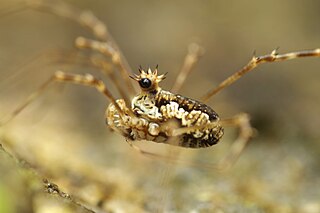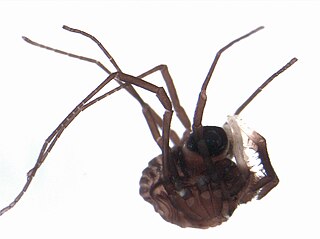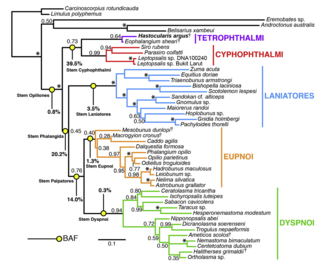
The Opiliones are an order of arachnids colloquially known as harvestmen, harvesters, harvest spiders, or daddy longlegs. As of April 2017, over 6,650 species of harvestmen have been discovered worldwide, although the total number of extant species may exceed 10,000. The order Opiliones includes five suborders: Cyphophthalmi, Eupnoi, Dyspnoi, Laniatores, and Tetrophthalmi, which were named in 2014.

Laniatores is the largest suborder of the arachnid order Opiliones with over 4,200 described species worldwide. The majority of the species are highly dependent on humid environments and usually correlated with tropical and temperate forest habitats.

Cosmetidae is a family of harvestmen in the suborder Laniatores. With over 700 species, it is one of the largest families in Opiliones. They are endemic of the New World with a Nearctic-Neotropical distribution where a large fraction of the diversity of Opiliones are represented by this single family. Cosmetidae have the northern extent of their range into the USA, where a small number species occur in the southern states. However, the family is especially diverse in Mexico, Central America and northern South America; especially the Andean realms. Their range also extends further south into Argentina and southern Brazil, but they are absent in Chile. Cosmetidae are prevalent in Amazonian region, but only relatively few also occur in Brazilian Atlantic Forest. Several species are also found in the Caribbean.

Dyspnoi is a suborder of harvestmen, currently comprising 43 extant genera and 356 extant species, although more species are expected to be described in the future. The eight families are currently grouped into three superfamilies: the Acropsopilionoidea, Ischyropsalidioidea, and Troguloidea.

Cyphophthalmi is a suborder of harvestmen, colloquially known as mite harvestmen. Cyphophthalmi comprises 36 genera, and more than two hundred described species. The six families are currently grouped into three infraorders: the Boreophthalmi, Scopulophthalmi, and Sternophthalmi.

The Phalangiidae are a family of harvestmen with about 380 known species. The best known is Phalangium opilio. Dicranopalpus ramosus is an invasive species in Europe.

Megabunus diadema is a species of harvestman distributed in Western Europe, where it has been found in Iceland, Faroe Islands, Western Norway, Great Britain, Western France, Belgium and Northern Spain.

The Phalangodidae are a family of harvestmen with about 30 genera and more than 100 described species, distributed in the Holarctic region.

Phalangioidea is a superfamily of the harvestman suborder Eupnoi with five recognized families and more than 1,500 species.

Caddoidea superfamily of harvestmen arachnids with a single family Caddidae, which now only contains 2 extant species. The family previously contained many more taxa under a previous wider concept, but the familial definition was narrowed after restudy.

An ozopore is the opening of a defensive gland present in some arthropods, notably in millipedes of the order Polydesmida and in harvestmen, the eight-legged arachnids also known as "daddy long-legs". The glands themselves are known as ozadenes, also called "scent glands", "repugnatorial glands", "odoriferous glands" or "stink glands" by various authors. The name is derived from Ancient Greek ozo "smell" and Latin porus "pore, small opening".
Nemastomoides is an extinct genus of harvestmen known from the Carboniferous fossil record. The genus is the only member of the family Nemastomoididae and contains three described species. Nemastomoides elaveris was found in the Coal Measures of Commentry in northern France, together with Eotrogulus fayoli.
Agoristenidae are a neotropical harvestman family of the Suborder Laniatores, in the superfamily Gonyleptoidea.

The Cranaidae are a family of neotropical harvestmen within the suborder Laniatores.
The Icaleptidae are a small family of neotropical harvestmen within the suborder Laniatores. Although only two species have been described, many more are probably to be discovered.
The Zalmoxidae are a family of harvestmen within the suborder Laniatores.

The Travuniidae are a small family of harvestman with little more than ten described species, within the suborder Laniatores.

The Cladonychiidae are a small family of harvestman with about 33 described species, within the suborder Laniatores.

Harvestmen (Opiliones) are an order of arachnids often confused with spiders, though the two orders are not closely related. Research on harvestman phylogeny is in a state of flux. While some families are clearly monophyletic, that is share a common ancestor, others are not, and the relationships between families are often not well understood.
Gonzalo Giribet is a Spanish-American invertebrate zoologist and Alexander Agassiz Professor of zoology working on systematics and biogeography at the Museum of Comparative Zoology in Harvard University. He is a past president of the International Society for Invertebrate Morphology, of the Willi Hennig Society, and vice-president of the Sociedad Española de Malacología.














